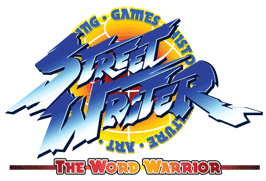A blog about my interests, mainly the history of fighting games. I also talk about animation, comic books, car culture, and art. Co-host of the Pink Monorail Podcast. Contributor to MiceChat, and Jim Hill Media. Former blogger on the old 1UP community site, and Capcom-Unity as well.
Showing posts with label x-men. Show all posts
Showing posts with label x-men. Show all posts
Thursday, August 6, 2020
The Street Writer Podcast, Episode 14
Sega and Konami released two high profile comic book licensed games in the same year. How many of you got a chance to play either of the titles featured in this episode?
If you would like to sponsor me please visit my Patreon page and consider donating each month, even as little as $1 would help make better blogs and even podcasts!
Monday, January 28, 2019
The Marvel Contest of Champions Legacy. part 3...
When fighting game fans think of Marvel fighting games they often go to the long-running series by Capcom. The first game in the series, X-Men vs Street Fighter debuted in 1996 and the most recent Marvel vs Capcom: Infinite debuted in 2017. Before the crossover titles Capcom had developed two unique fighting games that focused on a particular Marvel license. X-Men: Children of the Atom, a fighting game featuring heroes and villains from the X-Men comics debuted in 1995. That same year the studio also released Marvel Super Heroes, a fighting game inspired by the events in the Infinity War. The games featured highly stylized designs, high speed game play, brilliant animations, and a unique combo system. The Marvel Super Heroes title in particular allowed players to earn and use various Infinity Gems to give them a temporary power boost or special ability against their opponents. Of course at the end of the game Thanos would steal all six of the gems and use them against the player in true final boss fashion.
Marvel Contest of Champions (MCC) differed from the classic arcade fighters in a number of ways. In traditional arcade fighting games the battles only lasted a few seconds. Some of the more difficult battles in MCC could take several minutes to complete. Then there was the scale and scope of MCC. This was not just a game with one inevitable outcome. The Marvel multiverse and its inhabitants all depended on the player, known as the Summoner in the story. There were dozens of characters to unlock and play as, pulled from different realities. The game was also not a linear fighting game where you fought through a few characters, and wrapped up the story. There were tons of main quests and side quests to explore, each with their own special rules, and rewards. Players could earn experience for their champions, along with all sorts of collectible goods by "grinding" through the various missions. Players had to learn what items they should use to boost their characters stats and abilities before an encounter. This all added an additional level of strategy to each match. It was more like a fighting game-meets rpg-meets dungeon crawler.
A touch screen limited how complex most mobile games could really be, MCC was no exception to this rule. Most traditional fighting games used a six button layout, usually with a joystick or pad for directional inputs. The complex moves, and split-second timing from the Capcom games would be all but impossible to perform on a touch screen. Kabam simplified this, and inputs to simple taps. This didn't mean the game was simplistic. It still required learning the timing, and strategies for hundreds of potential encounters. Players had to learn when to activate certain counters, special attacks, and combinations. Otherwise they left themselves wide open to a counter attack. Players learned that certain characters worked well against one of the six classes; Cosmic, Mutant, Mystic, Skill, Science, and Tech. So just because you have a character with awesome powers, like Quake from Marvel's Agents of S.H.I.E.L.D, she didn't have the fighting prowess of Daredevil. In this way audiences learned to experiment and see which teams worked best for their style, and ability.
Best of all MCC draws equal parts from classic Marvel comics, and Marvel cinema. Both long time comic book fans and people new to the stories could be dropped right into the experience without missing a beat. In the Original Contest of Champions comic book the Grandmaster had organized the contest whereas in the Secret Wars it was the Beyonder. In the MCC the Collector was acting as the host of the tournament. The MCC took place in what was known as the Battlerealm. It was a nexus of different dimensions, and timelines that the Elders of the Universe had been shaping for their own entertainment. The idea of a dedicated arena was pulled from Secret Wars II in 1985. During that story Dr. Doom had temporarily gained the powers of the Beyonder. He hosted his tournament in what he called the Battleworld. The various locations released thus far in MCC did call out to specific locations that had been featured in over 40 years of Marvel comics. To help clarify the stakes and explain the new organizers Marvel released a 10-issue series titled Marvel Contest of Champions in 2015.
So how did Kabam hook new audiences without losing the veteran gamers? How did they strike a balance between easing players to a new game while still keeping it challenging. Of course the big question was how did they raise the stakes over any previous comic timeline? People that were just getting into fighting games, or mobile fighting games were probably familiar with the Avengers movies. Over the past 10 years Marvel had been building a cinematic empire that connected the various properties together. Almost every person today, young and old recognized Iron Man, Captain America, Black Widow, Hawkeye, and the Incredible Hulk thanks to these movies. They also knew the X-Men, and Spider-Man thanks to the films from other studios. What Kabam did was combine the live action licenses, including the characters that appeared on television, and placed them alongside their comic book counterparts. They managed to do all of this surprisingly well.
The contest organized by the Collector was simply one step in a much longer and more complex narrative. When Kabam released MCC only a few villains were revealed as organizers. Originally it was the Collector versus Kang the Conqueror, a time-travelling villain. They were battling over the ISO-Sphere, an item that allowed its owner to rewrite reality. This sphere was made up of ISO-8 crystals which champions earned in the game. All of this was explained in the comic. As the MCC series went on it changed organizers to include the Maestro. An evil version of the Hulk from the far future. In the "Future Imperfect" timeline he either killed or outlived all of the heroes and villains. The MCC also brought in the Grandmaster to act as an organizer. Of course what good was a contest if the Grandmaster could not participate, and show up his brother?
The ISO-Sphere was an all-powerful trophy, but long-time comic book fans were wondering if a different reality-changing item would appear in the series. Specifically one coveted by Thanos. The Infinity Gauntlet did exist in MCC, but not in the same way as the comic books, movies or even previous games had established. It took almost three years for Marvel Contest of Champions extend its version of the story, and the payoff was completely worth it. We shall explore this radical new world in the next blog. As always if you enjoyed this blog and would like to sponsor me please visit my Patreon page and consider donating each month, even as little as $1 would help make better blogs and even podcasts!
Wednesday, April 20, 2016
The Abridged History of the Brawler, part 9
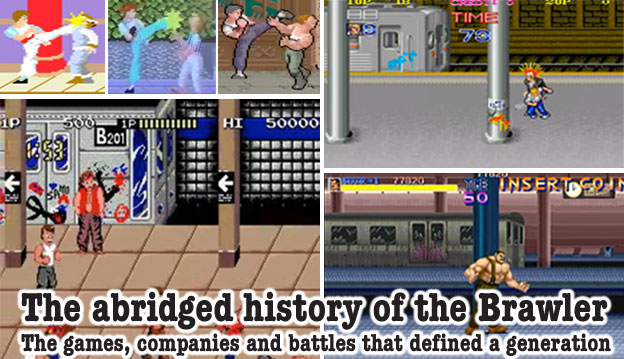
As 1991 was ending Sega was getting back aboard the arcade brawling bandwagon. Their last effort, Golden Axe, was met with favorable reviews. They studied the trends and were looking for a way to break the monopoly that Konami and Capcom were building. Sega was putting the finishing touches on their new arcade hardware, the System 32, which they felt was a powerful enough graphics engine to differentiate their next title from anything else out there. To show off their new processing power the first thing they did was secure a high profile license. They went to Marvel Comics and managed to get the license for Spider-Man. It was a surprise to me that Marvel would trust another Japanese developer following the debacle of Data East's Captain America game. What was even more surprising was that Sega had once gotten a cease and desist from Marvel because the original Shinobi featured a wall crawling ninja wearing red and blue tights at the end of Level 1 that looked an awful lot like Spider-Man.
Anyhow, the Sega game was a 4-player title featuring Spider-Man, the Black Cat, Namor the Submariner and Hawkeye. Unlike the hack job that was Captain America the developers seemed to have done research on the Marvel Universe and then went above and beyond in trying to recreate the western comic book format for arcades. The game was actually designed to reflect the pages of Marvel comics Characters would speak in word balloons, even during the fighting sequences. Level cinemas would play out in the panel per panel format. There was a certain gritty aesthetic to the visuals, as if it were a traditional 4-color traditional comic book come to life. The characters appeared to have been colored and even inked using traditional methods instead of strictly digitally. Proportionally there was something odd about the characters. They appeared as if a Japanese artist used to the manga format were trying their best to draw in the western style. The nuances of the poses, muscles and frames for the characters was slightly off compared to the actual Marvel model sheets. Not that it mattered, Sega released a game that was part brawler and part side-scrolling adventure.
The new graphics engine they created could scale the sprites with very little loss in fidelity. Sega used this to zoom out of action sequences and allow all four players to be seen climbing buildings, castles or going through caves independently. It was a groundbreaking gameplay and visual element
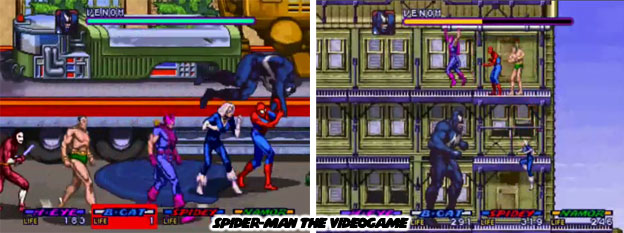
The game was fun if a bit hard. Unlike the Captain America game I didn’t mind putting quarters in this title. I’m not sure if it was a rare title but of all the arcades I visited in my youth I only saw two Spider-Man cabinets. Perhaps this lack of exposure was why the game was rarely mentioned in comic book to videogame comparisons.
Konami had a higher profile release with the six-player X-Men arcade game. The deluxe version of the cabinet was pure excess but could actually be found at several arcades I frequented. It was two oversized screens wide and featured a dedicated joystick and buttons for the individual characters. The massive cabinet was about as big as three regular cabinets stacked side by side. The wraparound art featuring full color graphics from the Marvel artists themselves was a statement to the industry as much as to gamers. Konami had declared themselves the all-time king of the brawler (and of licenses too).
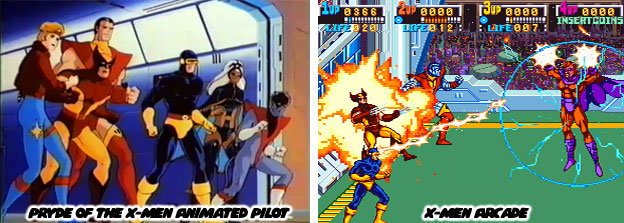
The game had a certain anime stylization rather than the comic format from Sega. This was because the 1992 brawler was based on an animated pilot from 1989. The Pryde of the X-Men was Marvel's first attempt at getting an X-Men animated series off the ground. It was produced by the Japanese Toei animation studios. That was the same studio that worked on other iconic shows from the 80’s including GI Joe, JEM and the Holograms and the Transformers.
My brothers and I loved the pilot episode and had wished that a series would have been made from it. The quality of the designs and animation were much better than the Fox Kids! series that appeared a few years later. But I digress…
The game itself pulled the locations and character designs right from the animated pilot. Each of the X-Men had a special, screen clearing attack based on their powers. For example, Storm could summon a series of whirlwinds and Nightcrawler could zap across the screen with his teleporting powers. Other powers, like Colossus' energy field were made up by the game designers, but this discrepancy was overlooked by most fans because the game was tremendous fun. It worked well with a single player but was best experienced when all six characters were on screen fighting off waves of robots, sentries and lizard men. The title was difficult as were the other Konami arcade brawlers and like those experiences the last level featured a battle royal against all of the previously defeated bosses.

Where Sega's hardware could render scalable sprites Konami's was capable of throwing sheer numbers on screen. Between the players and all the possible opponents there could be up to 16 large sprites on screen, fighting, shooting and performing vibrant special moves all without slowing down the game. It was an impressive feat that would have possibly been impossible on any other hardware.
One studio that tried their hand at the brawler would disappear as fast as they came. Tatsumi released Big Fight: Big Trouble in the Atlantic Ocean in 1992. The game was rarely, if ever seen in the arcades. It borrowed a number of elements from the Capcom brawlers, not the least of which were it's character designs, especially the gang members. The game was unique for a number of reasons. It took place entirely inside of a gigantic cruise ship / floating city. Players could actually select the path they were going to take at the end of each stage. This was one of the few games that allowed players to explore different branches.
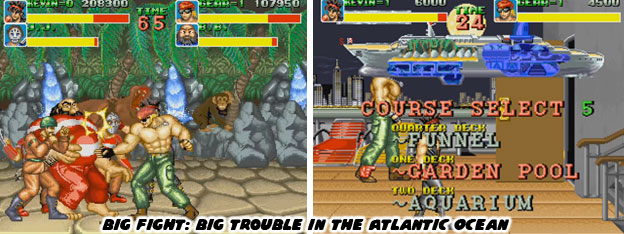
Something else that made the game unique was the story mode. If a player defeated a boss character then that boss could be selected as a playable character as well. The game was unique graphically for its use of parallax scrolling. Different layers of sprites moved at a different speed and it created the illusion of depth between the foreground and background. This was an important technique in the pre-3D era of game programming. Unfortunately the game was simply too ambitious to accomplish everything the studio wanted to. The control was lacking, the animation sloppy and the experience felt rushed. Tatsumi took their best shot and they should be remembered for pushing the genre forward.
Where Sega capped the end of 1991 with a big licensed title, Konami had given the genre another high-profile title in 1992. This buzz was important because there was a tremendous drop in the number of brawlers that year and a downward trend through the rest of the decade. I featured 18 games released in 1991 but only highlighted 8 for 1992. Those few numbers had not been seen since 1989. The brawler was a fun diversion but had fallen out of favor for most gamers. This was because Street Fighter II was released in 1991. The modern fighting game had arrived. The market changed overnight. Studios were busy answering the demand from audiences and arcade operators. Yet the brawler would not die, Konami, Capcom and now Sega would make sure of that. As always if you enjoyed this blog and would like to sponsor me please visit my Patreon page and consider donating each month, even as little as $1 would help make better blogs and even podcasts!
Subscribe to:
Posts (Atom)
